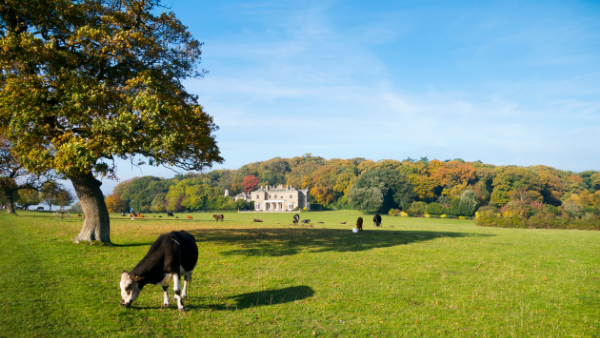Author
Read time: 6-7 minutes
Every year a number of ramblers are injured by cattle grazing land crossed by public footpaths. We consider the question of liability for damage and injury and highlight some steps farmers should take to assess and deal with the risk.
The Animals Act 1971
Tortious liability for damage caused by animals is largely governed by the Animals Act 1971 (“AA 1971 “). This Act creates a distinction between “dangerous species” and those which are not dangerous species.
Under Section 6(2) a dangerous species is a species—
(a) which is not commonly domesticated in the British Islands; and
(b) whose fully grown animals normally have such characteristics that they are likely, unless restrained, to cause severe damage or that any damage they may cause is likely to be severe.
The “type” of species kept is important as it dictates which rules for liability shall apply.
Dangerous species
Where damage is caused by an animal belonging to a dangerous species, the keeper of that animal shall be strictly (ie automatically) liable for any damage caused by it (s2(1), AA 1971). The keeper’s knowledge of the animal’s characteristics is irrelevant and it is more straightforward to prove liability.
Where damage is caused by an animal not belonging to a dangerous species, the hurdle to establish liability is much higher.
Under section 2(2), the injured person must establish all of the following matters to prove liability against the keeper:-
- the damage was of a kind which the animal, unless restrained, was likely to cause or if any damage caused was likely to be severe (s2(2)(a)); and
- the likelihood of the damage or of it being severe was because of characteristics of the animal, which are not normally found in that species or are only found at particular times or circumstances (s2(2)(b)); and
- the keeper of the animal (or another who was in charge of the animal as per s2(2)) knew of those characteristics (s2(2)(c)).
If all (a) to (c) can be established, then the keeper of the animal shall again be strictly liable.
Whilst liability is strict, there are defences to section 2 which include:-
- where damage was the fault of the person suffering it;
- where the claimant voluntarily accepted the risk of the damage; and
- where the person suffering damage was trespassing (subject to exceptions).
Bathie v Anthony
Bathie v Anthony [2021] is an example of a recent case under section 2(2) of the AA 1971.
Ms Bathie brought a claim under s2(2) (and also in negligence) after she was trampled by Mr Anthony’s cow in 2016.
Mr Anthony had cows which grazed land in the Anton Lakes Nature Reserve (“AL”) under a licence agreement. AL is fenced around the perimeter and has public footpaths crossing it. The cow in question had been let out to graze earlier in the day of the accident.
Ms Bathie’s account is that she was walking her dog on a lead at AL whilst on her mobile phone throughout. During her walk, she saw the cow around 14 feet in front of her. On seeing the cow, she turned around immediately, without engaging it and bent down to rotate her dog’s collar. When her back was turned, she was knocked to the ground by the cow and then trampled on, as was her dog; thereby causing injury.
Following the incident, Ms Bathie had spoken with the local authority’s parks and countryside manager. According to him, Ms Bathie had said at the time that the dog lead had become tangled with the cow and in trying to pull the dog away she ended up on the floor and was then trampled on by the cow. The judge appeared to accept that it was likely that the dog lead had become entangled.
The claim
Ms Bathie brought a claim under s2(2), AA 1971 and in negligence.
Mr Anthony accepted that s2(2)(a) was satisfied. The question was whether s2(2)(b) was also satisfied, giving rise to strict liability.
For the negligence claim, Ms Bathie claimed that Mr Anthony was negligent in grazing his herd in a field, which he knew the public walked across, with and without dogs. She claimed that:
- there should have been an electric fence to separate the herd; and
- the signage was inadequate to warn the public of the presence of the herd at AL.
Evidence
Whilst the judge considered the expert’s evidence to be of limited use, the judgment notes that it was agreed between them that:-
- All the cows would have been a little more anxious due to being transported to AL that day;
- It is likely that the cow was seeking water from the trough and that was the reason it was away from the herd;
- The cow was unlikely to be in full fight or flight mode and was not demonstrating full-blown fear state;
- The cow would have been anxious and instinctively wanted to return to the herd; and
- As Ms Bathie approached the cow, it would have turned to face a potential threat.
The judge also considered the breed of cattle used by Mr Anthony to graze AL to be “docile”.
Decision
S2(2) – Noting the above (and other factors), the judge found that s2(2)(b) had not been proved in this case and thus Mr Anthony was not strictly liable.
The judge considered the various scenarios and formed the view that a cow acting “inquisitively… would not arise from a characteristic that attracts strict liability under s2(2)(b)”. He considered it to be a “normal characteristic of a cow, not one that only arises at a particular time or in particular circumstances“. He made similar comments regarding the act of a cow returning to the rest of a herd after drinking water from a trough.
The judge also highlighted that where a cow, whose initial anxiety was allayed, returned to the herd normally with her head up, but not seeing Ms Bathie, caused her injury, this would not satisfy s2(2)(b).
Ms Bathie’s case was broadly that the cow, whether through aggression or anxiety, tried to return to the herd and safety, ignoring any obstacles in its path (including Ms Bathie whom it trampled). The judge found no evidence to support this assertion.
Negligence – Noting factors such as the cows being docile and public safety concerns with electric fences, the judge rejected the need for such a fence. In terms of the issue of signage, the judge rejected Ms Bathie’s account and accepted that there was appropriate signage, which Ms Bathie simply missed (due to being on her phone). Had she read the sign, she would not have entered AL.
The judge did not therefore accept Ms Bathie’s claim in negligence. Accordingly, Ms Bathie’s entire claim failed.
Comment
Whilst the animal liability offences discussed in this article are strict, the Bathie case makes it clear that a claimant will not automatically be successful under s2(2) AA 1971 upon suffering damage. Where the animal concerned is “non-dangerous” (under the Act), the claimant will still have to establish the three limbs of s2(2). The hurdles are not so high where the animal concerned is a dangerous species.
So, what steps can farmers take to protect the public and themselves from danger?
- Find out which category the animals fall within – if they are from a “dangerous species”, take action to keep them away from public footpaths or access areas.
- If not from a “dangerous species”, know the animals well
- If a farmer considers they pose or might pose a risk to the public, risk assessments and safety precautions should be taken.
- Consider erecting signage, fencing off footpaths, separate housing and installing CCTV. This will not only help avoid incidents which fall under section 2 of the AA 1971, but will also help protect against a negligence claim.

